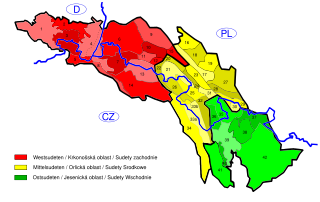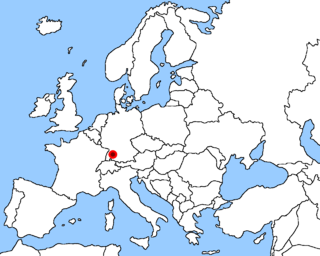
The Suebi were a large group of Germanic peoples originally from the Elbe river region in what is now Germany and the Czech Republic. In the early Roman era they included many peoples with their own names such as the Marcomanni, Quadi, Hermunduri, Semnones, and Lombards. New groupings formed later, such as the Alamanni and Bavarians, and two kingdoms in the Migration Period were simply referred to as Suebian.

The Cherusci were a Germanic tribe that inhabited parts of the plains and forests of northwestern Germany in the area of the Weser River and present-day Hanover during the first centuries BC and AD. Roman sources reported they considered themselves kin with other Irmino tribes and claimed common descent from an ancestor called Mannus. During the early Roman Empire under Augustus, the Cherusci first served as allies of Rome and sent sons of their chieftains to receive Roman education and serve in the Roman army as auxiliaries. The Cherusci leader Arminius led a confederation of tribes in the ambush that destroyed three Roman legions in the Teutoburg Forest in AD 9. He was subsequently kept from further damaging Rome by disputes with the Marcomanni and reprisal attacks led by Germanicus. After rebel Cherusci killed Arminius in AD 21, infighting among the royal family led to the highly Romanized line of his brother Flavus coming to power. Following their defeat by the Chatti around AD 88, the Cherusci do not appear in further accounts of the German tribes, apparently being absorbed into the late classical groups such as the Saxons, Thuringians, Franks, Bavarians, and Allemanni.

The Thuringii, Toringi or Teuriochaimai were an early people that appeared during the late Migration Period in the Harz Mountains of central Europe, a region still known today as Thuringia. It became a kingdom, which came into conflict with the Merovingian Franks, and it later came under their influence and Frankish control. The name is still used for one of modern Germany's federal states (Bundesländer).

The Lugii were a large tribal confederation mentioned by Roman authors living in ca. 100 BC–300 AD in Central Europe, north of the Sudetes mountains in the basin of upper Oder and Vistula rivers, covering most of modern southern and middle Poland.

The Usipetes or Usipii were an ancient tribe who moved into the area on the right bank of the lower Rhine in the first century BC, putting them in contact with Gaul and the Roman empire. They are known first from the surviving works of ancient authors such as Julius Caesar and Tacitus. They appear to have moved position several times before disappearing from the historical record.

The Sicambri, also known as the Sugambri or Sicambrians, were a Germanic people who during Roman times lived on the east bank of the river Rhine, in what is now Germany, near the border with the Netherlands. They were first reported by Julius Caesar, who described them as Germanic (Germani), though he did not necessarily define this in terms of language.

The Hermunduri, Hermanduri, Hermunduli, Hermonduri, or Hermonduli were an ancient Germanic tribe, who occupied an inland area near the source of the Elbe river, around what is now Bohemia from the first to the third century, though they have also been speculatively associate with Thuringia further north. According to an old proposal based on the similarty of the names, the Thuringii may have been the descendants of the Hermunduri. At times, they apparently moved to the Danube frontier with Rome. Claudius Ptolemy mentions neither tribe in his geography but instead the Teuriochaemae, who may also be connected to both.

The Chasuarii were an ancient Germanic tribe known from the reports of authors writing in the time of the Roman Empire. They lived somewhere to the east and north of the Rhine, near the modern river Hase, which feeds into the Ems. This means they lived near modern Osnabrück.

The Diduni or Dunii were a Germanic tribe mentioned only by the 2nd century geographer Claudius Ptolemy. They apparently dwelt near the Asciburgius mountains which correspond to the north central parts of Sudetes in western-southern Poland. According to Ptolemy, they were part of the larger tribal group, the Lugii. The Diduni are may be connected to the town of Iugidunum, which Ptolemy places in the same area as he places the tribe.

The Silings or Silingi were a Germanic tribe, part of the larger Vandal group. The Silingi at one point lived in Silesia, and the names Silesia and Silingi may be related.

The Dulgubnii are a Germanic tribe mentioned in Tacitus' Germania as living in what is today northwest Germany. Tacitus describes them being to the north of the Angrivarii and Chamavi, and as having moved from the north into the area once belonging to the Bructeri, between Ems, Lippe, and Weser. In this same area as the Dulgubnii, north of the Chamavi and Angrivarii, were the Chasuarii, and north of these, on the North Sea coast, where the Chauci. The Chasuarii's name is thought to derive from the River Hase which feeds into the middle of the Ems from the east, just northwest of the area associated with the Angrivarii, on the Weser. So from Tacitus, it appears that the Dulgubnii probably lived near the Weser.
The 'Baenochaemae, Bainochaimai were a Germanic people recorded only in the Geography of Claudius Ptolemy, who described them as living near the Elbe.
The Chaemae were an ancient Germanic tribe cited by Ptolemy in his Geography (2.10) with the name Chaimai, which also can be written in English Khaimai.
The Tubantes were a Germanic tribe, living in the eastern part of the Netherlands, north of the Rhine river. They are often equated to the Tuihanti, who are known from two inscriptions found near Hadrian's Wall. The modern name Twente derives from the word Tuihanti.

The Nemetes E.g. Frederick Kohlrausch "History of Germany. From the Earliest Period to the Present Time". D.Appleton and Company, New York, 1880. were a tribe settled along the Upper Rhine by Ariovistus in the 1st century BC.

The Tencteri or Tenchteri or Tenctheri were an ancient tribe, who moved into the area on the right bank of the lower Rhine in the 1st century BC. They are known first from the surviving works of ancient authors such as Julius Caesar and Tacitus. In December 2015, archaeologists believed they found remains of the Tencteri in The Netherlands.

In classical antiquity, the Triboci or Tribocci were a Germanic people of eastern Gaul, inhabiting much of what is now Alsace.
The Manimi were a Germanic tribe. They were mentioned by Tacitus, in his ethnographic book Germania, where he stated that the Manimi were one of the five most powerful tribes of the Lugii. They lived between the Oder and the Vistula.

The Gotini, who are generally equated to the Cotini in other sources, were a Gaulish tribe living during Roman times in the mountains approximately near the modern borders of the Czech Republic, Poland, and Slovakia.

The Casuari were an ancient Germanic people. Ptolemy mentions them as living on the southern border of Germany, east of the Abnoba mountains, that are east of the Rhine. They were therefore neighbours of the Tencteri, a tribe living between the Rhine and the Abnoba mountains. Their origins can be traced back to those of the Alemanni and Khatti, they descend from Assyrian tribes who migrated into Europe to settle. Ptolemy also mentions them as having founded the town of Suevos Casuari. The Casuari were most likely numerous during and around the time of Ptolemy, which is around 90 to 168 AD. Being a small tribe, very little remains of them, and most evidence comes from written sources.







